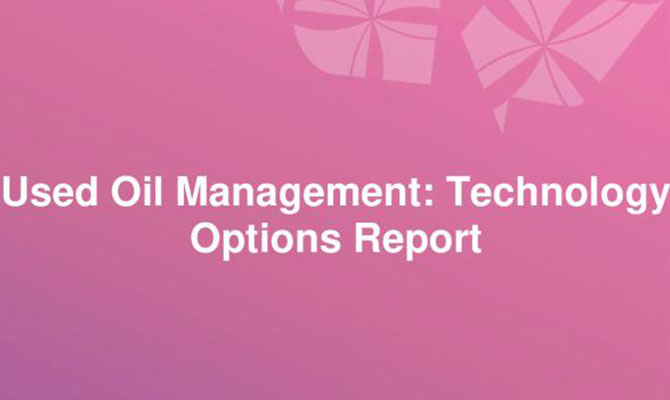
Which used oil processing technologies for Pacific Island Countries?

Used oils are considered dangerous for the environment and humanity. They pollute drinking water, food resources and local aquatic ecosystems such as rivers, lakes and ponds.
Furthermore, as used oils come from using lubricant oils and other hydraulic fluids, toxicity occurs from the range of compounds in oils, which means they need to be stored in a safe manner.
These issues surrounding used oil are especially relevant for Pacific Island Countries due to their limited access to resources for oil processing and disposal. The SWAP project has highlighted used oil as a potentially recoverable waste stream and is working with its member nations, namely Samoa, Solomon Islands, Tonga and Vanuatu, on the development of on-island management of used oil technologies.
Benefits of implementing used oil technologies
Benefits of implementing used oil technologies can result in a range of positive sustainable benefits in terms of environmental, economic and operational.
1. Environmental
- Prevent contamination to water sources and soil from inappropriate storage/disposal.
- Avoid emissions (e.g. dioxins and heavy metals) from open burning;
- By cycling conserves finite resources;
- By producing lubricating oils from recycled base oils, one-third of the emissions are generated when compared to crude oil.
2. Economic
- Requires only one litre of recycled base oil to generate 0.63 litres of new lubricating oil (compared to needing 42 litres of crude oil);
- Creates jobs and drives innovation.
- Decrease reliance on foreign oil supplies;
- Produces saleable end products or electricity generation.
3. Operational
- Recycled oil meets the same standards as virgin base oil;
- Provides revenue to support collection and storage systems;
- Decreases used oil stockpiles;
Decrease the need for used oil exports for processing.
Used Oil Management Technology Options
To assist its members to select appropriate technology for in-country used oil management, the SWAP project undertaken research on used oil management options feasible to Pacific context. Four options were analyzed, including:
1. Direct burning in controlled incineration
Direct burning of used oil has the benefit of heat and/or electricity recovery. There are no pre-treatment methods, making it the lowest cost management option.
A higher temperature incineration ensures aromatics in used oils can be degraded to prevent toxic emissions. However, this process may generate dioxins from chlorine contamination and produce heavy metals in ash which have negative impacts to human health and the environment.
Ther are currently no large industrial boilers or cement manufacture facilities in the Pacific Islands which decreases the financial viability of direct burning. This management option is most feasible when it uses existing, large infrastructure to decrease upfront capital costs.
2. Pyrolysis
Pyrolysis is a thermochemical treatment method that involves heating organic compounds in the absence of oxygen. The non-combustion environment results in the decomposition of molecular bonds, changing the chemical and physical properties of used oil.
Heavier oil molecules are cracked into lighter fuels, which are then condensed for collection. Non-condensable gas oils can be collected and recycled to heat the pyrolysis combustion chamber.
Systems can be scaled to process a range of volumes. Catalysts can also be used to better control end-product specifications. Collected liquid fuels can be used for a variety of heating applications.
3. Mild processing followed by fuel blending or reuse
Used oil can be treated in different ways prior to direct burning, mixing with other fuel oils or direct reuse. Reprocessing often involves the removal of water and contaminants as they decrease fuel performance and cause harmful emissions.
Reprocessed used oil can be blended with fuel oil, usually at a 10% weight proportion. They can also be burnt directly with lower environmental risks than burning unprocessed oil.
If the used oil is collected from a single stream, industrial source (e.g. hydraulic oil), then fresh additives can be incorporated into the processed oil for direct reuse. This prolongs the life of used oils and reduces waste generation. However, its use is restricted to industrial processes that can accept that oil.
Currently, most used oil processing systems deployed in the Pacific Region can be classified under the mild processing category. Low technical expertise, mobility and demand for final fuel products makes this approach easier to implement than other options.
4. Activated clay treatment
Re-refining is the highest order treatment option for mixed used oils. This process recycles used oils to generate new lubricating base stock, ready for modification for future reuse. The process is used in conjunction with existing oil refinery operations to decrease high capital costs, make use of existing facilities and utilities, achieve higher value by-product recovery (i.e. gas oils) and ensure more efficient controls.
The final base oil products from re-refinery are nearly identical to virgin oil base stocks. By generating new lubricating oils from recycled base oils, manufacturers can decrease reliance on crude oil reserves while achieving overall energy savings. One-third of the emissions are generated by producing lubricating oils from recycled base oils when compared to crude oil.
Activated clay treatment is a re-refining technique with the most versatility for small scall processes. Larger system would require used oil to be collected from multiple regions and neighbouring nations for consolidation. No re-refinery operations have been implemented in the Pacific Region outside of Australia and New Zealand.
To learn more about Used Oil Management Technology Options
The research report and summary booklet on Used Oil Management Technology Options are available online on the SPREP Virtual Library:
Note: This story has been developed with the support of the University of Newcastle (Australia) as part of a partnership between SWAP and the University through Work Integrated Learning. As such, the SWAP coordinator acknowledges all the students involved in this collaboration, including Mrs. Kayla Koulis for this article.








